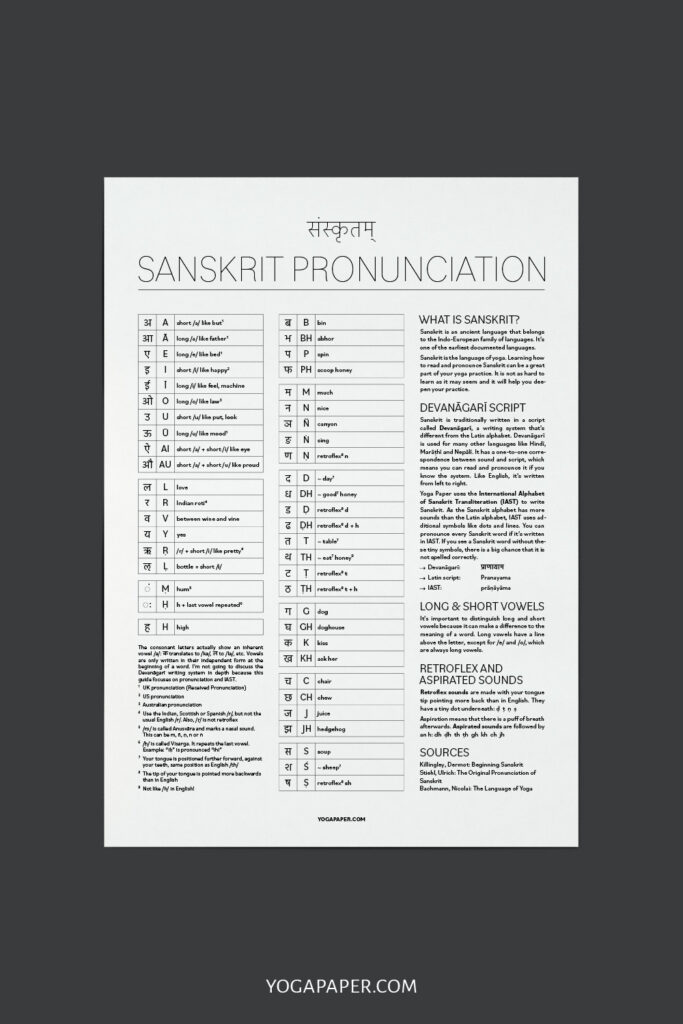What is Sanskrit?
Sanskrit is an ancient language that belongs to the Indo-European family of languages. It‘s one of the earliest documented languages.
Sanskrit is the language of yoga. Learning how to read and pronounce Sanskrit can be a great part of your yoga practice. It is not as hard to learn as it may seem and it will help you deepen your practice.
Devanagari Vs. Latin Script
Sanskrit is written in a script called Devanāgarī, a writing system that‘s different from the Latin alphabet. Devanāgarī is used for many other languages like Hindi, Marāṭhī and Nepālī. It has a one-to-one correspondence between sound and script, which means you can read and pronounce it if you know the system. Like English, it‘s written from left to right.
Yoga Paper uses the International Alphabet of Sanskrit Transliteration (IAST) to write Sanskrit. As the Sanskrit alphabet has more sounds than the Latin alphabet, IAST uses additional symbols like dots and lines. You can pronounce every Sanskrit word if it’s written in IAST. If you see a Sanskrit word without these tiny symbols, there is a big chance that it is not spelled correctly.
- Devanāgarī: प्राणायाम
- Latin script: Pranayama
- IAST: prāṇāyāma
Free Download: Sanskrit Pronunciation Guide (PDF)
Want to know how to pronounce Sanskrit words on your own? This 1-page PDF explaines what Sanskrit symbols look like along with a few examples.
This printable Sanskrit pronunciation guide is for you, if …
- you’re interested in learning how to pronounce Sanskrit words correctly
- you’re confused about how to say yoga poses, chakras, mantras, etc. in Sanskrit
- you’re a yoga teacher
- you plan to do a yoga teacher training
- you want to have a full list of the Sanskrit Alphabet in Devanāgarī and IAST
- you’re a visual learner
- you prefer a printed version ⮕ you can print this free download at home!


How to get the free file
- Subscribe to the newsletter
- Receive the password
- Download your free file
Sanskrit Alphabet and Pronunciation: Devanagari, IAST and English examples
Vowels
It’s important to distinguish long and short vowels because it can make a difference to the meaning of a word. Long vowels have a line above the letter, except for e and o, which are always long vowels.
Usually, vowels are not written in their independent form. I‘m not going to discuss the Devanāgarī writing system in depth because I want to focus on IAST and Sanskrit pronunciation here.
| Sanskrit Devanāgarī | Sanskrit IAST | Pronunciation Example |
|---|---|---|
| अ | a | short a like but |
| आ | ā | long a like father |
| ए | e | long e like bed |
| इ | i | short i like happy |
| ई | ī | long i like feel, machine |
| ओ | o | long o like law |
| उ | u | short u like put, look |
| ऊ | ū | long u like mood |
| ऐ | ai | short a + short i like eye |
| औ | au | short a + short u like proud |
Notes:
- Use the UK pronunciation (Received Pronunciation) for but, father, bed and mood.
- Use the US pronunciation for happy
- Use the Australian pronunciation for law
Semi Vowels
The Devanāgarī writing system is somewhat unique in that the consonant letters actually show an inherent vowel ‘a’: ल translates to ‘la’, र translates to ‘ra’, etc . I’ve made the decision to leave out the inherent ‘a’ in this blog post.
| Sanskrit Devanāgarī | Sanskrit IAST | Pronunciation Example |
|---|---|---|
| ल | l | love |
| र | r | Indian roti |
| व | v | between wine and vine |
| य | l | yes |
| ऋ | ṛ | pretty |
| ॠ | ṝ | Rita |
| ऌ | ḷ | bottle + short i |
Sanskrit R
- r – Use the Indian /r/, Scottish /r/ or Spanish /r/, but not the usual English /r/.
- syllabic ṛ – Although the dot underneath the ṛ makes it look like a retroflex, this is not actually a retroflex sound
- ṝ is a very rare sound
Visarga, Anusvāra and H
| Sanskrit Devanāgarī | Sanskrit IAST | Pronunciation Example |
|---|---|---|
| ◌ं | ṃ | hum |
| ◌ः | ḥ | h + last vowel repeated |
| ह | h | high |
- ṃ is called Anusvāra and marks a nasal sound. This can be m, ñ, ṇ, n or ṅ. Experts disagree on how it’s pronounced.
- ḥ is called Visarga. It repeats the last vowel. Example: “iḥ” is pronounced “ihi”
Consonants
| Sanskrit Devanāgarī | Sanskrit IAST | Pronunciation Example |
|---|---|---|
| ब | b | bin |
| भ | bh | abhor |
| प | p | spin |
| फ | ph | scoop honey |
| म | m | much |
| न | n | nice |
| ञ | ñ | canyon |
| ङ | ṅ | sing |
| ण | ṇ | retroflex n |
| द | d | ~ day |
| ध | dh | ~ good honey |
| ड | ḍ | retroflex d |
| ढ | ḍh | retroflex d + h |
| त | t | ~ table |
| थ | th | ~ eat honey |
| ट | ṭ | retroflex t |
| ठ | ṭh | retroflex t + h |
| च | c | chair |
| छ | ch | chew |
| ज | j | juice |
| झ | jh | hedgehog |
| स | s | soup |
| श | ś | ~ sheep |
| ष | ṣ | retroflex sh |
Retroflex sounds
The tip of your tongue is pointed more backwards than in English. They have a tiny dot underneath.
- Retroflex sounds are: ḍ ṭ ṇ ṣ
Aspirated Sounds
Aspiration means that there is a puff of breath afterwards. Aspirated sounds are followed by an h.
- Aspirated sounds are : dh ḍh th ṭh gh kh ch jh
- Unaspirated sounds are: d ḍ t ṭ g k c j
- In Sanskrit, the letter “th” is pronounced in a completely different way than how English pronounces “th”!
S- and Sh-Sounds
- s – use your regular s-sound.
- ś – your tongue is more forward than in English “sh”
- ṣ – your tongue tip is pointing more back than in English “sh”
Dental Sounds
d, dh, t, th, ś – Your tongue is positioned further forward, against your teeth, same position as English “th”
Sources
- Killingley, Dermot: Beginning Sanskrit
- Stiehl, Ulrich: The Original Pronunciation of Sanskrit
- Bachmann, Nicolai: The Language of Yoga
